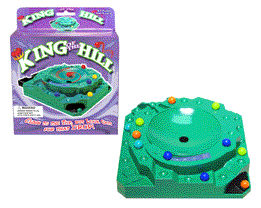This article has multiple issues. Please help improve it or discuss these issues on the talk page . (Learn how and when to remove these messages)
|
 Box and game | |
| Publishers | Winning Moves Schaper Toys |
|---|---|
| Players | 2 to 4 |
| Setup time | 2 minutes |
| Playing time | 20–30 minutes |
| Chance | Medium |
| Age range | 8 and up |
King of the Hill is a race game, where players try to be the first to get their marbles from the start to the top of the mountain. It was originally published by Schaper Toys in 1960. It was re-released in 2006 with slightly different rules by Winning Moves Games USA, but is no longer in production.